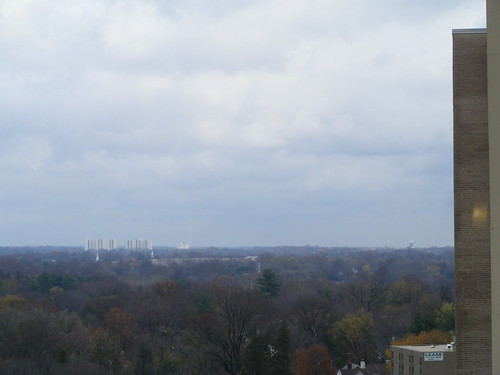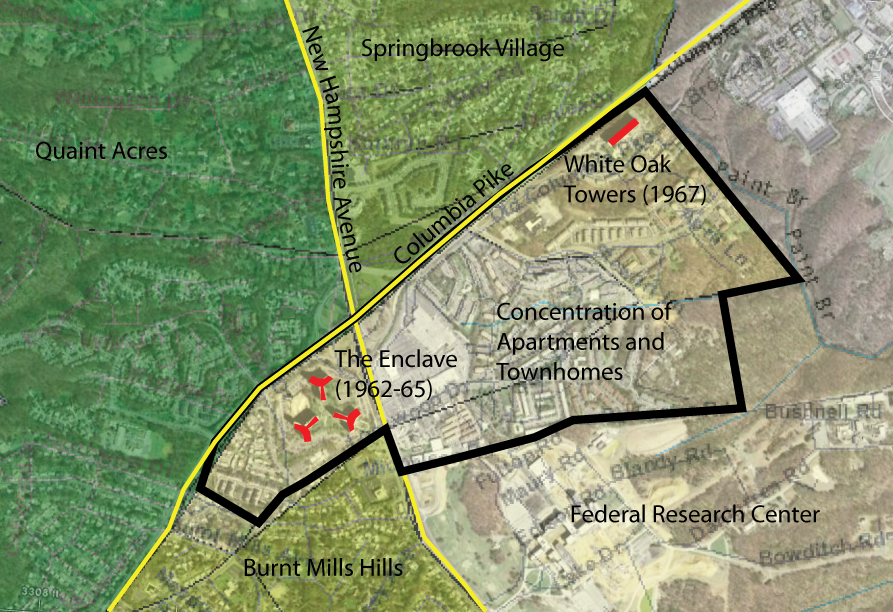 Toronto, Canada wants to find ways to use the land around 1960's-era "towers in the park" to better serve their residents. In East County, one developer built townhouses around Waterford Tower, an apartment building on Castle Boulevard.
Toronto, Canada wants to find ways to use the land around 1960's-era "towers in the park" to better serve their residents. In East County, one developer built townhouses around Waterford Tower, an apartment building on Castle Boulevard.During the 1960’s and 70’s, East Montgomery County experienced a high-rise building boom, with apartment towers sprouting up as far north as Burtonsville. A rough count shows there are over forty apartment buildings with more than eight stories in East County outside of Downtown Silver Spring, many of which are clustered in White Oak, Leisure World and along University Boulevard.
Today, these buildings designed for young professionals and small families fleeing the city are showing their age at a time when everyone’s moving back downtown. Not only that, but forty-year-old high-rises aren’t very energy-efficient. In Toronto, Canada, which has over a thousand such buildings, Mayor David Miller has launched a project to bring them into the twenty-first century.
Dense but often surrounded by generous lawns, these “towers in the park” can be isolating for their residents. Entire neighborhoods filled with these buildings and lower-density garden-style apartments are too diffuse (and often too poorly connected) to provide easy access to shopping and transit.
 East County apartment towers seen from Georgian Towers in Downtown Silver Spring.
East County apartment towers seen from Georgian Towers in Downtown Silver Spring.The goal of the Mayor’s Tower Renewal initiative is to a) make the buildings “green” with extra insulation and replacing obsolete materials and b) to find new uses for the land around the buildings, whether it’s as public parkland, vegetable gardens, or for amenities like rec centers, shops and restaurants, or even offices. This is how architect Graeme Stewart, who began developing this concept as a grad student at the University of Toronto, describes it:
"Right now neighborhoods offer residential density, but they're employment and service deserts," says Stewart. "The idea that to solve it, you would add more density seems sort of strange -- and I think that's going to be the biggest point of contention to the neighboring areas -- but at the same time, during early engagement with the communities, people are saying, 'I'd like a grocery store,' 'I'd like to be able to open up a small business.' It almost seems like a no-brainer. The fact that these neighborhoods have been ignored and stayed the same for so long is actually what's weird about them."This seems like a proposal ready-made for East County’s apartment towers. “Filling in the gaps” between high-rises would provide extra income for landlords and developers; reduce car trips by locating amenities where people already live; offer places for kids to hang out; and provide space for small businesses to locate (not unlike my "shop-house" proposal last year), generating jobs in a community that definitely needs them.
 This Census map (above) depicting average household income in White Oak by color (with darker green representing wealthier areas) shows that residents of the Enclave and White Oak Towers, two 1960’s-era high-rise buildings, are poorer than their counterparts in surrounding single-family neighborhoods. (They are wealthier than people living in White Oak’s more affordable garden-style buildings, but this may be because high-rise apartments are more expensive to maintain and thus charge higher rents.)
This Census map (above) depicting average household income in White Oak by color (with darker green representing wealthier areas) shows that residents of the Enclave and White Oak Towers, two 1960’s-era high-rise buildings, are poorer than their counterparts in surrounding single-family neighborhoods. (They are wealthier than people living in White Oak’s more affordable garden-style buildings, but this may be because high-rise apartments are more expensive to maintain and thus charge higher rents.)Places like White Oak and Briggs Chaney have been maligned for creating congestion and “demographic shifts” in East County, while their residents are isolated from the larger community and even from people living in the next apartment complex. Tower Renewal, or whatever you’d like to call it, could transform areas like White Oak and Briggs Chaney into vibrant neighborhoods and “town centers.”
We’re already seeing elements of Tower Renewal in this area. Lofts 590, a new building in Crystal City, returned low-rise scale to a 60’s-era complex of apartment towers in a park. And in Briggs Chaney, townhouses were built around the Waterford Tower on Castle Boulevard, giving existing residents an opportunity to “move up” into larger housing without leaving the neighborhood.
While neither of these projects go quite far as what’s being proposed in Toronto – they’re still isolated from the community and do nothing to address the issues of accessibility and energy use – they’re a sign that developers and communities alike are open to the possibilities of recycling the “tower in the park.”

No comments:
Post a Comment